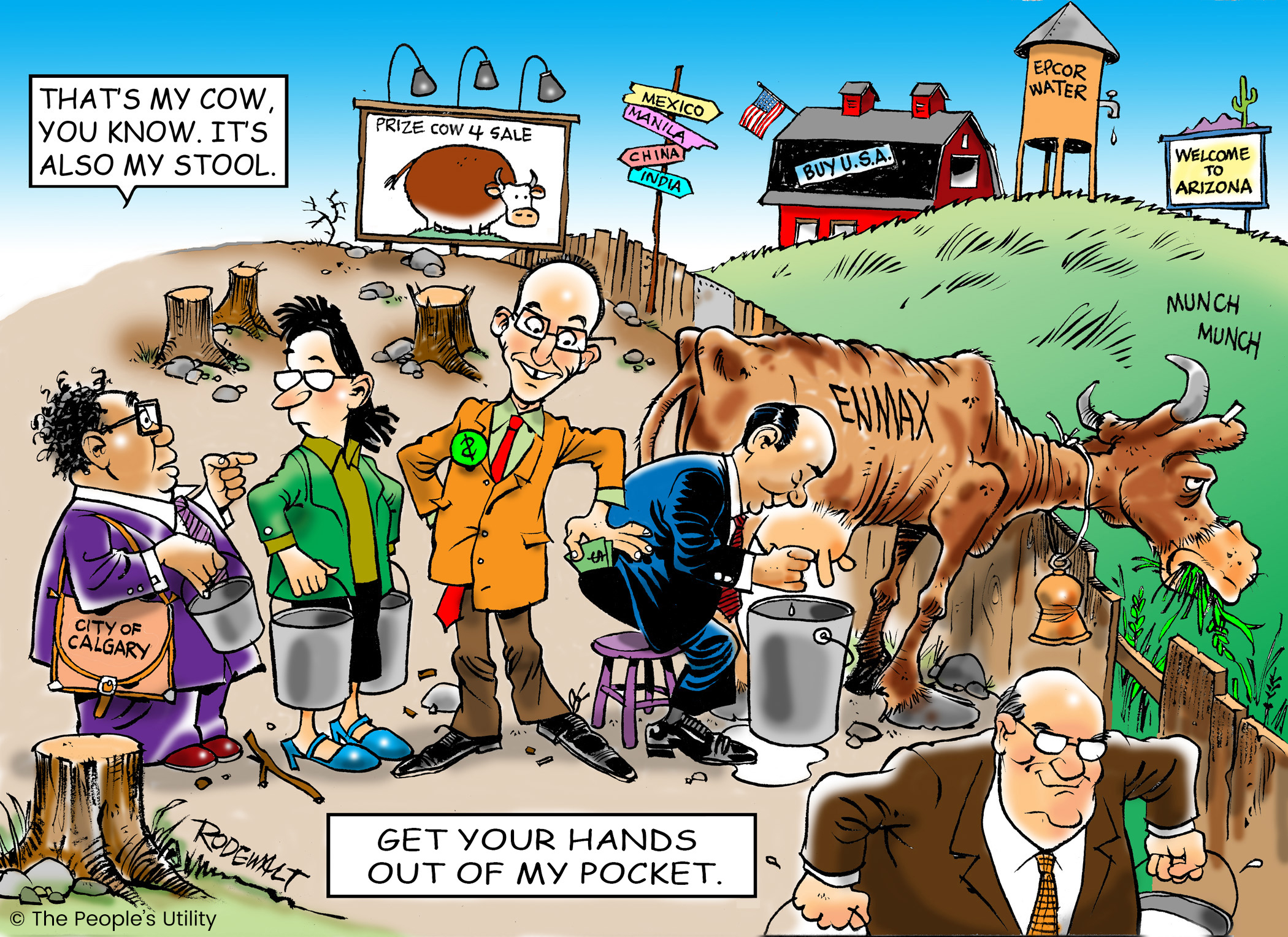Problems and Solutions: We are all in for a rough time ahead in the energy sector. If you understand the problems, the solutions may be easier to digest. Albertans are resilient, yet at the same time we need our political leaders to make tough decisions and spend our tax dollars wisely.
Everyone knows the harsh reality, that in Calgary, unemployment runs high. Over 25% of the office space in downtown towers sit empty. Good paying jobs in the electricity industry have been outsourced. ENMAX, ATCO and Direct Energy have all shipped jobs to companies either in India, the Philippines, Guatemala, or the United States. But what are we doing to solve this problem?
Not only have jobs been outsourced, utility assets are being sold off to foreign companies. In 2018 Direct Energy sold off its Alberta natural gas holdings to a consortium out of China. ATCO as well sold off their Information Technology division (ATCO iTek) to a company in India. AltaGas has started to liquidate and in 2019 is targeting the sale of additional assets with the intent of regaining its financial strength and focus on its midstream and U.S. utilities business. Sadly, stories like this are becoming more and more common.
The utility market is complicated and an expensive commitment. To put this into perspective, the provincial government’s green strategy needs an estimated $25 billion dollars of investment in generation by 2030. To attract investment dollars the province has been convinced that it needs to offer revenue certainty to investors if new generation is going to be built to replace the coal plants that are being closed.
Next on the horizon, Bill 13 is scheduled to be implemented in 2021. This ‘Capacity Payment’ mechanism will be designed to guarantee a fixed payment to generators, thus providing long-run revenue certainty. The prime objective of the new market design is premised on resource adequacy and minimizing price volatility. This comes at a cost of potentially higher overall cost and shifting some of the investment risks to consumers as well as higher administrative burdens. The bottom line; consumer prices will more than likely go up.
Closing and mothballing coal plants prematurely destabilized the market and increased volatility in energy prices. Over the last 12 months the cost of electricity has more than doubled. Given the current political uncertainty, plus the willingness of the government to subsidize anything that is green, it is understandable that communities and corporations are lining up for the freebie prior to committing to invest their own money. Hundreds of millions will simply disappear: much of which is funded out of the Carbon Tax (aka the consumers back pocket).
In the Oil and Gas sector, our premier is now being called upon to make one very tough decision: curtail oil production to try to reduce the surplus and pump up wholesale prices. It is argued that this is a wise decision, but is it enough? Next on the horizon, the premier is considering subsidizing the building of refineries.
There is an interesting parallel to the new Oil & Gas strategy when you look at what is happening in the electricity industry: let’s remember that we closed coal plants and paid out $2 billion in penalties. By shorting the wholesale market supply, the cost of electricity increased by over 100% between 2017 and 2018. In a poorly designed policy, in order to try to soften the blow of higher regulated electricity retail prices, the government started subsidizing the utilities in an effort to cap the regulated retail rate at 6.8 cents/kWh. This subsidy isn’t being fairly distributed as it only goes to utilities providing regulated rates and the other half of the consumers in the province get nothing. Over the life of the policy, it could cost taxpayers upwards of $700 million. Pyramiding subsidies, deficit financing and adding to the provincial debt, plus expecting consumers to pay the bill needs to stop.
With all of this said, our political leaders, both provincial and municipal have never before been so challenged. Politicians inevitably will fall back on adding to the deficit, increasing taxation and spending our tax dollars on subsidies. This is a classic formula; until the working people run out of money to pay the taxes. And if the Carbon Tax is rolled back – who is going to pay for all the subsidies that the government is handing out?
Calgarians are now facing the next problem: increased property taxes. This year, home owners will face a 3.45% tax hike and business owners will see about a 10% increase. As a point of reference, the property tax on our office in Inglewood has increased 100% between 2014 and 2018. Small businesses no doubt will feel the sting of another increase this year.
The mayor of Calgary and our Premier have a tough job ahead. We all need to pitch in and offer our politicians some practical solutions, but will they listen to our suggestions? With the above as a backdrop, lets take a look at Calgary’s crown jewel; ENMAX.
Calgary’s Cash Cow
ENMAX suffered a Net Operating Loss of just under $140 million last year on revenue of $3 billion. Dividends paid to the city are down from $60 million in 2013 to $40 million today. Why is ENMAX running in the red? Why are dividends down by 30%?
Looking back a dozen years, the long-term debt of our city utility was comfortably being managed when it was in the range of $400 million. Today this has ballooned to over $1.7 billion.
Yet the outlook remains positive in the corporate offices at ENMAX, even in today’s challenging market as the utility faces; higher systems costs, aging infrastructure, increases in operational costs, discounting retail prices and reduced electricity margins, taxation challenges, and several disputes with counterparties. Are our city councillors willing to sit back and watch the debt increase and dividends decline?
Here are five possible solutions Mayor Nenshi may want to consider:
- Sell ENMAX. This is a good time to sell off the retail sector of ENMAX and keep the lucrative wires and transmission business. This would reduce the city’s debt, focus on job creation, and bring jobs that were exported out of country back to Calgary. Use the profits on the sale of ENMAX to invest in the city in an effort to try to re-create a positive investment climate. Consolidate and re-Invest. As a point of reference, this is exactly what firms like AltaGas are doing right now – and the shareholders were rewarded with an increase in stock value. It is a wise strategy for the city to seriously consider.
- Reduce Taxes. In review of ENMAX’s financial statements, there is hidden tax collected by ENMAX and paid to the city under the heading of Local Access Fees (LAF). During the first nine months of 2018, the city of Calgary has collected $103 million from consumers in Calgary, up from $67.5 million paid by consumers in 2016 (+ 50% increase in two years). The Local Access Fee (LAF) is a fee paid by consumers and set in agreement with the City of Calgary in lieu of property taxes and other fees or charges payable to the City by ENMAX Power.
Consumers can find the LAF on their monthly utility bill. Ask yourself, is the LAF charged to consumers by Calgary reasonable? To answer this question, consider that a typical electricity customer in Calgary pays 125% more than a consumer in Edmonton. In some areas in Alberta residents pay zero, and residents in the Town of Milo actually get a rebate. Recommendation: follow the formula established in other municipalities and help Calgarians reduce the tax burden paid on electricity consumption by redesigning the Local Access Fee.
- Move off of the RRO. We can save hundreds of millions of dollars if consumers simply get off of the regulated rate. If they did this, the regulators wouldn’t need to artificially subsidize the profit margin of ENMAX and other utilities, money which comes out of the Carbon Tax.
If you want to help Calgarians, they should be encouraged to get off the Regulated Utility Rate and sign up for a competitive rate today. If customers want to stay with ENMAX they should be encouraged to do so – and simply move over to the EasyMax arm of the company. Consumers will save on their electricity bill and carbon tax money can be spent on programs, more important than guaranteeing the profit margin of the utility. Alternatively, there are over 20 Energy Marketers in Alberta, like Park Power, all selling electricity below the subsidized cap. Everyone wins and we can stop wasting Carbon Tax dollars.
- Stop predatory business practices. In an attempt to pick up consumer market share, ENMAX, while wearing its EasyMax hat, has been gifting away money in a promotional strategy. At the same time, the corporation is often rumoured to bid on energy contracts below market value in order to undercut the competition. Predatory pricing designed to drive competition out of the local market is simply wrong; especially when at the same time you are increasing our business tax, the money of which indirectly is being used to compete against private sector retailers like Park Power. Is it any wonder that companies are leaving Calgary and the province of Alberta?
If ENMAX has money to spare, it should be fulfilling its civic responsibility and increasing its dividends to the city. The mayor needs to wrangle the city’s cash cow.
- Support local jobs: Over the years, ENMAX has shipped jobs out of the country. Today, they are using Tata Consultancy Services (TCS), a massive multinational company headquartered in Mumbai, India for back-end technology support jobs. This move has been justified by leadership as a way to compete on the same playing field as other corporations. We have many talented people living in Calgary who need jobs, we need to bring the jobs back home.
Searching for Greener Pastures?
ATCO is currently diversifying and recently invested in plans to build a new generation plant in Mexico, as well as investments in South America. EPCOR moved money out of Edmonton and purchased water utilities in the United States. Given that ATCO and EPCOR have money to invest – maybe they could be encouraged to buy ENMAX rather than hunting for greener pastures outside of the country. Hopefully ENMAX doesn’t add to our debt load by trying to follow EPCOR into the States and buying a utility down south.
Mayor Nenshi can help consumers lower their taxes by simply restructuring the Local Access Fees, can offer some good advice for consumers to jump off of the government Regulated Option Rate Option (RRO) for electricity, bring jobs back to Canada that ENMAX has sent offshore, and promote the theme “Shop Locally”.
All problems have a solution. It is time for tough decisions and we need political leaders who are willing to think out of the box. Reduce taxes. Reduce subsidies. Reduce debt.



thank you for the article